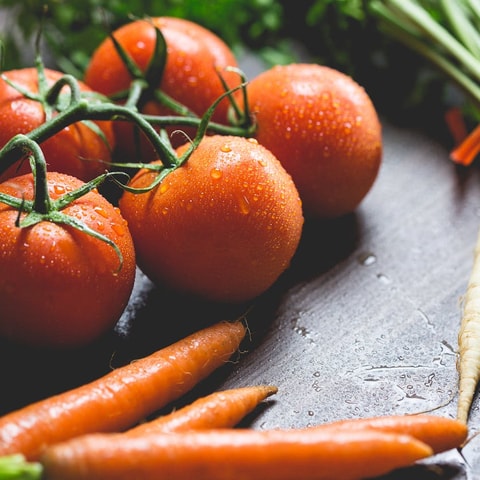Health Benefits of Fruits and Vegetables by Color
"Discover the benefits of fruit and vegetables according to their colour and how each shade provides key nutrients to improve your health and wellbeing"
By Ana Velazquez - 06/Feb/2025
Picture: Nadine Primeau

The colour of natural foods, such as pulses, vegetables, fruits and greens, is not only an attractive visual feature, but also an indicator of the nutrients and beneficial compounds they provide to our bodies. Each colour is associated with different vitamins, minerals and antioxidants that are essential for maintaining good health and preventing disease.
Benefits of Red-coloured Foods

Red foods, such as watermelon, tomatoes, strawberries, red or pink grapefruit and papaya, are rich in health-promoting compounds. These include lycopene and ‘anthocyanins’, two types of antioxidants that play a crucial role in protecting the body against various health problems. Lycopene, for example, has been associated with reduced risk of cardiovascular disease and certain types of cancer, while anthocyanins, found in many red fruits, also offer anti-inflammatory and anti-cancer properties. In addition, these antioxidants contribute to the overall well-being of the urinary system, helping to prevent infections and improving kidney function. It has also been shown that regular consumption of lycopene- and anthocyanin-rich fruits can have positive effects on memory and cognitive function, promoting healthy ageing. These fruits are part of the carotenoids group, which are responsible for giving them their characteristic red colour. Therefore, incorporating these foods into the daily diet not only improves cardiovascular health, but also supports the immune system, combats oxidative stress and promotes a sharp memory and a healthy urinary system.
Benefits of Yellow Foods
Including yellow foods in your diet can bring a variety of health benefits. These foods, such as corn, bananas, yellow peppers and potatoes, are rich in lutein, a natural substance that plays a key role in protecting the eyes. Lutein is an antioxidant that helps protect the retina from damage caused by prolonged exposure to the sun's rays, thereby helping to maintain good eye health and reducing the risk of problems such as age-related macular degeneration. In addition to their benefits for the eyes, yellow foods also have properties that promote prevention of ulcers and premature ageing. Lutein, along with other nutrients found in these foods, acts as a powerful antioxidant to combat the effects of oxidative stress, which is one of the main factors responsible for premature ageing of skin and other tissues. By including these foods in your diet, you will not only improve your eye health, but also help keep your skin younger and protected, while reducing the risk of gastric ulcers. Incorporating a variety of yellow foods into your daily meals is a great way to take care of your visual and overall health in a holistic way.
Benefits of Blue, Purple and Violet Foods
Fuits and vegetables with these colours, such as grapes, aubergine, plums, beets, blueberries, cherries and purple cabbage, are rich in flavonoids and anthocyanins. These powerful antioxidant compounds help improve blood circulation, strengthen the cardiovascular system and reduce the risk of chronic diseases. They also possess anti-carcinogenic, anti-inflammatory and anti-tumour properties, which contribute to the prevention of various diseases. Incorporating these foods into the daily diet promotes brain health, protects against cellular ageing and strengthens the immune system.
Benefits of Green Foods

Green vegetables, such as spinach, broccoli, lettuce, cucumber and avocado, are rich in B vitamins, essential for the proper functioning of the nervous system. They also contain vitamin K, essential for blood clotting and bone health. They are also an excellent source of folic acid, an essential nutrient during pregnancy, as it contributes to the proper development of the baby and prevents congenital malformations. Their high fibre content, antioxidants and minerals such as magnesium and potassium make them key allies for digestive health, blood pressure regulation and strengthening the immune system.
Benefits of Orange Foods
Orange coloured fruits and vegetables, such as carrots, pumpkin, oranges, mangoes, peaches and peppers, are rich in beta-carotene and vitamin C. Beta-carotene, a precursor of vitamin A, promotes eye health, strengthens the immune system and contributes to the maintenance of healthy skin. Vitamin C acts as a powerful antioxidant, helping to keep skin soft and smooth, as well as stimulating collagen production and boosting the body's defences. These compounds also reduce the risk of cardiovascular disease and certain types of cancer, thanks to their ability to fight cell damage and inflammation.
Benefits of White Foods
White vegetables, such as onions, garlic, leeks, cauliflower and mushrooms, contain bioactive compounds with multiple health benefits. These include allicin, found in garlic and onions, which helps to reduce blood glucose levels, cholesterol and triglycerides, promoting cardiovascular health. In addition, these foods have antimicrobial and anti-inflammatory properties, strengthening the immune system and helping to prevent infections. Their regular consumption is also associated with antioxidant and protective effects against chronic diseases.